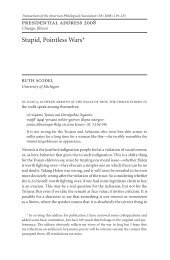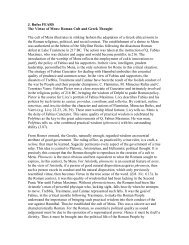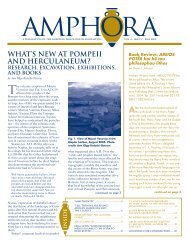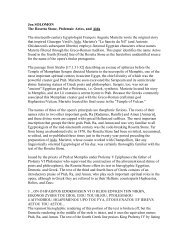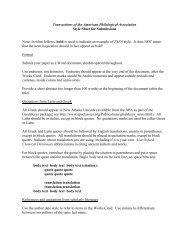classics rewritten in stone: the art of anita huffington - American ...
classics rewritten in stone: the art of anita huffington - American ...
classics rewritten in stone: the art of anita huffington - American ...
Create successful ePaper yourself
Turn your PDF publications into a flip-book with our unique Google optimized e-Paper software.
16<br />
THE ROMANS IN GAUL TODAY: LIVING<br />
HISTORY AND EXPERIMENTAL ARCHAEOLOGY<br />
IN THE RHÔNE-ALPES REGION OF FRANCE<br />
cont<strong>in</strong>ued from page 3<br />
performed, and visitors wandered across<br />
acres <strong>of</strong> <strong>the</strong> site. At night <strong>the</strong>re was an<br />
open-air projection <strong>of</strong> <strong>the</strong> 1963 film<br />
Jason and <strong>the</strong> Argonauts directed by Don<br />
Chaffey and starr<strong>in</strong>g Todd Armstrong<br />
and Nancy Kovack.<br />
S<strong>in</strong>ce <strong>the</strong> 2006 European edition <strong>of</strong><br />
<strong>the</strong> Gallo-Roman Days was a success,<br />
ano<strong>the</strong>r European edition was organized<br />
<strong>in</strong> 2008 featur<strong>in</strong>g reenactors from<br />
France, Germany, Italy, Switzerland,<br />
Spa<strong>in</strong>, and Belgium. The Journées<br />
Gallo-Roma<strong>in</strong>es 2008 reta<strong>in</strong>ed many <strong>of</strong><br />
<strong>the</strong> popular features from previous years<br />
and added o<strong>the</strong>rs. A new feature <strong>in</strong>cluded<br />
<strong>the</strong> p<strong>art</strong>icipation <strong>of</strong> two groups that<br />
specialize <strong>in</strong> reenact<strong>in</strong>g earlier warriorcultures:<br />
<strong>the</strong> Spanish group, A<strong>the</strong>na<br />
Promakhos, which reenacts Greek<br />
hoplite warfare from <strong>the</strong> Archaic<br />
through <strong>the</strong> Hellenistic periods, and<br />
Arbeitsgruppe Hallstattzeit, a German<br />
group recreat<strong>in</strong>g Celtic warriors from<br />
<strong>the</strong> eighth century to <strong>the</strong> fifth century<br />
B.C. Throughout <strong>the</strong> weekend Roman,<br />
Gallic, and Germanic warriors and civilians<br />
paraded on <strong>the</strong> site. The Swiss<br />
reenactors <strong>of</strong> Vexillum Legio XI<br />
Claudia Pia Fidelis brought a scorpio and<br />
fired it at targets. The pottery kilns (see<br />
Fig. 25) were work<strong>in</strong>g. W<strong>in</strong>e historian<br />
Michel Bouvier <strong>in</strong>troduced visitors to<br />
ancient-style w<strong>in</strong>es – quite tasty, <strong>in</strong> fact<br />
– made as an archaeological experiment<br />
from v<strong>in</strong>es grown on <strong>the</strong> site, while<br />
Christian Girbal, who makes reproductions<br />
<strong>of</strong> ancient <strong>in</strong>struments, gave a<br />
demonstration <strong>of</strong> Celtic music. Probably<br />
<strong>the</strong> most dramatic addition <strong>in</strong> 2008 was<br />
<strong>the</strong> <strong>in</strong>vited p<strong>art</strong>icipation <strong>of</strong> <strong>the</strong> Corpus<br />
Equitum Legionis X Equestris from<br />
Belgium, a group specializ<strong>in</strong>g <strong>in</strong> Roman<br />
cavalry. Two members <strong>of</strong> <strong>the</strong> Belgian<br />
group came with <strong>the</strong>ir horses and for<br />
about thirty m<strong>in</strong>utes, performed a variety<br />
<strong>of</strong> maneuvers.<br />
The Journées Gallo-Roma<strong>in</strong>es have<br />
been a popular success. In 2007 <strong>the</strong><br />
museum recorded over 3000 visitors to<br />
<strong>the</strong> site. The fact that <strong>the</strong> work <strong>of</strong> <strong>the</strong><br />
reenactors is supported by a national<br />
museum and pr<strong>of</strong>essional archaeologists<br />
assures <strong>the</strong> quality and accuracy <strong>of</strong> <strong>the</strong><br />
exercise. The groups, too, hold high<br />
standards: some, like Pax Augusta, have<br />
<strong>the</strong> sponsorship <strong>of</strong> university pr<strong>of</strong>essors<br />
such as Christian Goud<strong>in</strong>eau, Pr<strong>of</strong>esseur<br />
au Collège de France and Chaire d’Antiquités<br />
Nationales.<br />
Why, <strong>the</strong>n, are <strong>the</strong> Gallo-Roman<br />
Days important? Why should educators<br />
and scholars care about <strong>the</strong> work <strong>of</strong> historical<br />
reenactors? In addition to <strong>the</strong><br />
pleasure <strong>of</strong> visit<strong>in</strong>g a beautiful French<br />
site <strong>in</strong> early June, <strong>the</strong> event gives both<br />
specialists and amateurs <strong>the</strong> chance to<br />
see th<strong>in</strong>gs <strong>in</strong> books brought to life.<br />
Although no group has succeeded <strong>in</strong><br />
recreat<strong>in</strong>g <strong>the</strong> size <strong>of</strong> a Roman legion,<br />
even see<strong>in</strong>g a few soldiers <strong>in</strong> accurately<br />
designed uniforms, carry<strong>in</strong>g and manipulat<strong>in</strong>g<br />
reproductions <strong>of</strong> ancient<br />
weapons, helps our understand<strong>in</strong>g <strong>of</strong> <strong>the</strong><br />
period. S<strong>in</strong>ce <strong>the</strong> legions drill <strong>in</strong> Lat<strong>in</strong> –<br />
and even <strong>the</strong> gladiatorial exhibitions use<br />
some Lat<strong>in</strong> – we also get <strong>the</strong> chance to<br />
hear this beautiful ancient language.<br />
But <strong>the</strong>se are all <strong>the</strong> th<strong>in</strong>gs <strong>of</strong> liv<strong>in</strong>g<br />
history. Experimental archaeology is<br />
someth<strong>in</strong>g else. In a recent <strong>art</strong>icle<br />
Gilbert expla<strong>in</strong>s an experiment he conducted<br />
with Pax Augusta. On <strong>the</strong> weekend<br />
<strong>of</strong> May 12-13, 2007, <strong>the</strong> men <strong>of</strong> Pax<br />
Augusta set out from <strong>the</strong> small town <strong>of</strong><br />
Aoste <strong>in</strong> <strong>the</strong> dép<strong>art</strong>ement <strong>of</strong> Isère to follow<br />
a ten kilometer (6.2 miles) course<br />
through <strong>the</strong> countryside. Their objective<br />
was to test <strong>the</strong> conditions <strong>of</strong> <strong>the</strong><br />
Roman army on campaign. The twenty<br />
men on <strong>the</strong> march represent<strong>in</strong>g soldiers<br />
<strong>of</strong> <strong>the</strong> Fifth Legion were to test march<strong>in</strong>g<br />
and travel<strong>in</strong>g conditions, each man<br />
carry<strong>in</strong>g a kit and equipment that<br />
weighed 40.7 kilograms (89.5 lbs.). The<br />
soldiers were accompanied by two mule<br />
drivers with <strong>the</strong>ir mules and eight<br />
women represent<strong>in</strong>g <strong>the</strong> soldiers’ concub<strong>in</strong>es.<br />
Dur<strong>in</strong>g <strong>the</strong> course <strong>of</strong> <strong>the</strong>ir trek,<br />
<strong>the</strong> Roman soldiers were to stop, dig<br />
entrenchments, pitch camp, test <strong>the</strong> fortifications,<br />
and <strong>the</strong>n make <strong>the</strong> return<br />
march with <strong>the</strong>ir civilian followers to<br />
Aoste. Unbeknownst to anyone <strong>in</strong> Pax<br />
Augusta except Gilbert and <strong>the</strong> mule<br />
drivers, (<strong>the</strong> mule drivers were <strong>in</strong>formed<br />
as a preventive measure: no one wanted<br />
to deal with surprised animals), <strong>the</strong> men<br />
<strong>of</strong> Pax Augusta were also to be subjected<br />
to an attack by members <strong>of</strong> ano<strong>the</strong>r<br />
reenactment group, Leuki. The members<br />
<strong>of</strong> Leuki, who specialize <strong>in</strong> Gallic<br />
reenactment, were to adopt <strong>the</strong> personae<br />
<strong>of</strong> German warriors for this weekend<br />
experiment. The encounter between<br />
Roman soldiers and Germanic warriors<br />
would give <strong>the</strong> Roman reenactors <strong>of</strong><br />
Pax Augusta <strong>the</strong> occasion to test <strong>the</strong>ir<br />
reactions to a surprise attack.<br />
One should keep <strong>in</strong> m<strong>in</strong>d <strong>the</strong> fact<br />
that, when Pax Augusta conducted<br />
<strong>the</strong>se experiments, <strong>the</strong>y were p<strong>art</strong>icipat<strong>in</strong>g<br />
as well-<strong>in</strong>formed amateurs: Pax<br />
Augusta is not a branch <strong>of</strong> <strong>the</strong> French<br />
army. However, <strong>the</strong> Frenchmen <strong>in</strong> <strong>the</strong><br />
group over thirty-years <strong>of</strong> age have done<br />
obligatory national military service and<br />
o<strong>the</strong>rs have actually served for longer<br />
periods <strong>of</strong> time or are currently still<br />
serv<strong>in</strong>g <strong>in</strong> <strong>the</strong> regular French army. So<br />
<strong>the</strong> men who conducted <strong>the</strong> experiment<br />
were <strong>in</strong> shape and were aware <strong>of</strong> <strong>the</strong><br />
exigencies <strong>of</strong> military life. In any case,<br />
as Gilbert later observed, whe<strong>the</strong>r <strong>the</strong><br />
p<strong>art</strong>icipants were or had been <strong>in</strong> <strong>the</strong><br />
armed forces or not was <strong>of</strong> limited value,<br />
for <strong>the</strong> conditions <strong>of</strong> ancient and modern<br />
warfare are quite different.<br />
The Roman reenactors dep<strong>art</strong>ed<br />
from Aoste amid <strong>the</strong> farewells <strong>of</strong> <strong>the</strong><br />
townspeople and schoolchildren; but,<br />
except for two pr<strong>of</strong>essional photographers<br />
and two video cameramen, no one<br />
came to watch <strong>the</strong> march. In o<strong>the</strong>r<br />
words, <strong>the</strong> expedition was not a show<br />
for enterta<strong>in</strong>ment, but an experiment to<br />
test equipment and human endurance<br />
<strong>in</strong> conditions made to simulate a crosscountry<br />
march through enemy territory.<br />
So <strong>the</strong> Romans marched and were<br />
attacked by <strong>the</strong> Germans. The Romans<br />
repelled <strong>the</strong> attack and, though tired,<br />
built <strong>the</strong>ir camp; but <strong>the</strong>n <strong>the</strong>y were<br />
attacked aga<strong>in</strong> and <strong>the</strong> sturd<strong>in</strong>ess <strong>of</strong><br />
<strong>the</strong>ir camp defenses was tested. Gilbert<br />
also reports that, although <strong>the</strong>y were<br />
us<strong>in</strong>g blunted weapons, many <strong>of</strong> <strong>the</strong><br />
weapons broke, render<strong>in</strong>g <strong>the</strong> pieces<br />
dangerous, as if <strong>the</strong>y were spikes. Thus<br />
<strong>the</strong> reenactors learned not only someth<strong>in</strong>g<br />
about surprise attacks and test<strong>in</strong>g<br />
fortifications, but that broken weapons<br />
on <strong>the</strong> battlefield represented potential<br />
danger to ancient armies.<br />
In addition to recreat<strong>in</strong>g military life<br />
<strong>in</strong> a legion dur<strong>in</strong>g <strong>the</strong> early Empire,<br />
members <strong>of</strong> Pax Augusta also recreate<br />
<strong>the</strong> world <strong>of</strong> <strong>the</strong> gladiators. The reproduction<br />
<strong>of</strong> various gladiator helmets,<br />
Fig. 25. For Gallo-Roman Days 2008,<br />
pottery kilns were built on site under <strong>the</strong><br />
direction <strong>of</strong> C.N.R.S archaeologist<br />
Armand Desbat.


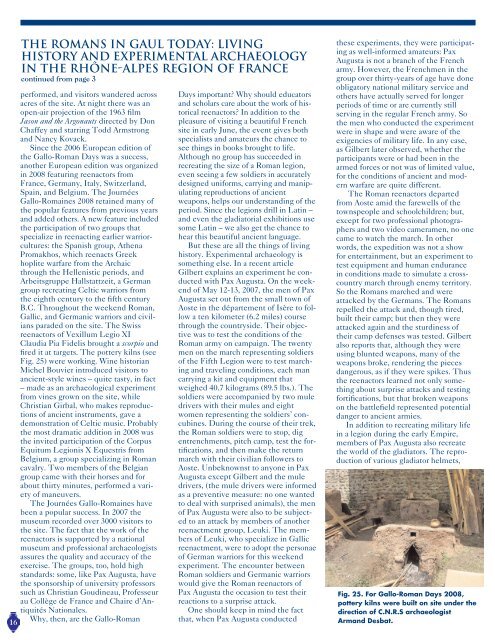
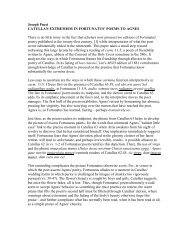
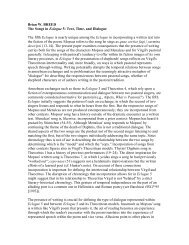
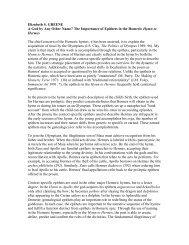

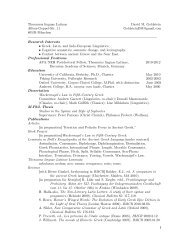
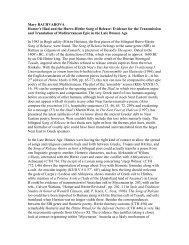

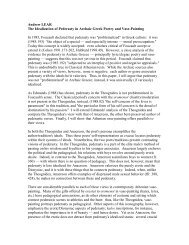
![John H. STARKS, Jr. [vo]cales vultus:Pantomime Actresses in Latin ...](https://img.yumpu.com/11930335/1/190x245/john-h-starks-jr-vocales-vultuspantomime-actresses-in-latin-.jpg?quality=85)
